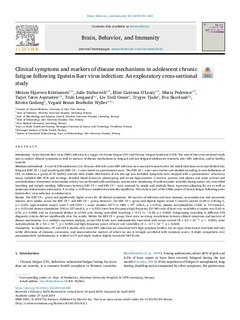| dc.contributor.author | Kristiansen, Miriam Skjerven | |
| dc.contributor.author | Stabursvik, Julie | |
| dc.contributor.author | O'Leary, Elise Catriona | |
| dc.contributor.author | Pedersen, Maria | |
| dc.contributor.author | Asprusten, Tarjei Tørre | |
| dc.contributor.author | Leegaard, Truls Michael | |
| dc.contributor.author | Osnes, Liv T. N. | |
| dc.contributor.author | Tjade, Trygve Olav | |
| dc.contributor.author | Skovlund, Eva | |
| dc.contributor.author | Godang, Kristin | |
| dc.contributor.author | Wyller, Vegard Bruun Bratholm | |
| dc.date.accessioned | 2019-11-13T13:07:39Z | |
| dc.date.available | 2019-11-13T13:07:39Z | |
| dc.date.created | 2019-06-27T11:32:25Z | |
| dc.date.issued | 2019 | |
| dc.identifier.citation | Brain, behavior, and immunity. 2019, 80 551-563. | nb_NO |
| dc.identifier.issn | 0889-1591 | |
| dc.identifier.uri | http://hdl.handle.net/11250/2628278 | |
| dc.description.abstract | Introduction
Acute Epstein-Barr virus (EBV) infection is a trigger of chronic fatigue (CF) and Chronic Fatigue Syndrome (CFS). The aim of this cross-sectional study was to explore clinical symptoms as well as markers of disease mechanisms in fatigued and non-fatigued adolescents 6 months after EBV-infection, and in healthy controls.
Materials and methods
A total of 200 adolescents (12–20 years old) with acute EBV infection were assessed 6 months after the initial infectious event and divided into fatigued (EBV CF+) and non-fatigued (EBV CF−) cases based on questionnaire score. The EBV CF+ cases were further sub-divided according to case definitions of CFS. In addition, a group of 70 healthy controls with similar distribution of sex and age was included. Symptoms were mapped with a questionnaire. Laboratory assays included EBV PCR and serology; detailed blood leukocyte phenotyping and serum high-sensitive C-reactive protein; and plasma and urine cortisol and catecholamines. Assessment of autonomic activity was performed with continuous, non-invasive monitoring of cardiovascular variables during supine rest, controlled breathing and upright standing. Differences between EBV CF+ and EBV CF− were assessed by simple and multiple linear regression adjusting for sex as well as symptoms of depression and anxiety. A p-value ≤ 0.05 was considered statistically significant. This study is part of the CEBA-project (Chronic fatigue following acute Epstein-Barr virus infection in adolescents).
Results
The EBV CF+ group had significantly higher scores for all clinical symptoms. All markers of infection and most immune, neuroendocrine and autonomic markers were similar across the EBV CF+ and EBV CF− group. However, the EBV CF+ group had slightly higher serum C-reactive protein (0.48 vs 0.43 mg/L, p = 0.031, high-sensitive assay), total T cell (CD3+) count (median 1573 vs 1481 × 106 cells/L, p = 0.012), plasma norepinephrine (1420 vs 1113 pmol/L, p = 0.01) and plasma epinephrine (363 vs 237 nmol/L, p = 0.032); lower low-frequency:high frequency (LF/HF) ratio of heart rate variability at supine rest (0.63 vs 0.76, p = 0.008); and an attenuated decline in LF/HF ratio during controlled breathing (−0.11 vs −0.25, p = 0.002). Subgrouping according to different CFS diagnostic criteria did not significantly alter the results. Within the EBV CF+ group, there were no strong correlations between clinical symptoms and markers of disease mechanisms. In a multiple regression analysis, serum CRP levels were independently associated with serum cortisol (B = 4.5 × 10−4, p < 0.001), urine norepinephrine (B = 9.6 × 10−2, p = 0.044) and high-frequency power of heart rate variability (B = –3.7 × 10−2, p = 0.024).
Conclusions
In adolescents, CF and CFS 6 months after acute EBV infection are associated with high symptom burden, but no signs of increased viral load and only subtle alterations of immune, autonomic, and neuroendocrine markers of which no one is strongly correlated with symptom scores. A slight sympathetic over parasympathetic predominance is evident in CF and might explain slightly increased CRP levels. | nb_NO |
| dc.language.iso | eng | nb_NO |
| dc.publisher | Elsevier | nb_NO |
| dc.rights | Attribution-NonCommercial-NoDerivatives 4.0 Internasjonal | * |
| dc.rights.uri | http://creativecommons.org/licenses/by-nc-nd/4.0/deed.no | * |
| dc.title | Clinical symptoms and markers of disease mechanisms in adolescent chronic fatigue following Epstein-Barr virus infection: An exploratory cross-sectional study | nb_NO |
| dc.type | Journal article | nb_NO |
| dc.type | Peer reviewed | nb_NO |
| dc.description.version | publishedVersion | nb_NO |
| dc.source.pagenumber | 551-563 | nb_NO |
| dc.source.volume | 80 | nb_NO |
| dc.source.journal | Brain, behavior, and immunity | nb_NO |
| dc.identifier.doi | 10.1016/j.bbi.2019.04.040 | |
| dc.identifier.cristin | 1708252 | |
| dc.description.localcode | © 2019 The Authors. Published by Elsevier Inc. This is an open access article under the CC BY-NC-ND license (http://creativecommons.org/licenses/BY-NC-ND/4.0/). | nb_NO |
| cristin.unitcode | 194,65,20,0 | |
| cristin.unitname | Institutt for samfunnsmedisin og sykepleie | |
| cristin.ispublished | true | |
| cristin.fulltext | original | |
| cristin.qualitycode | 2 | |

